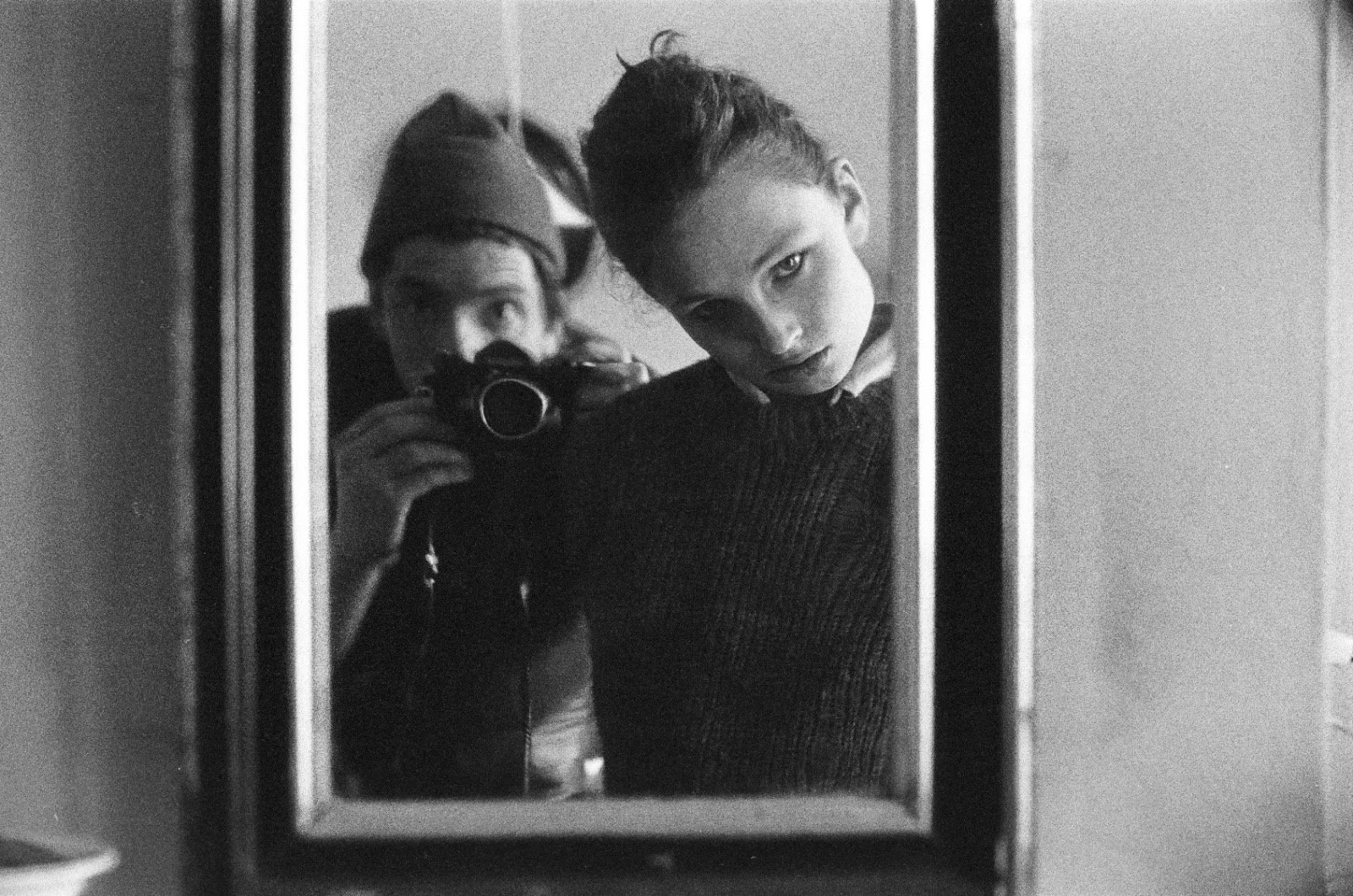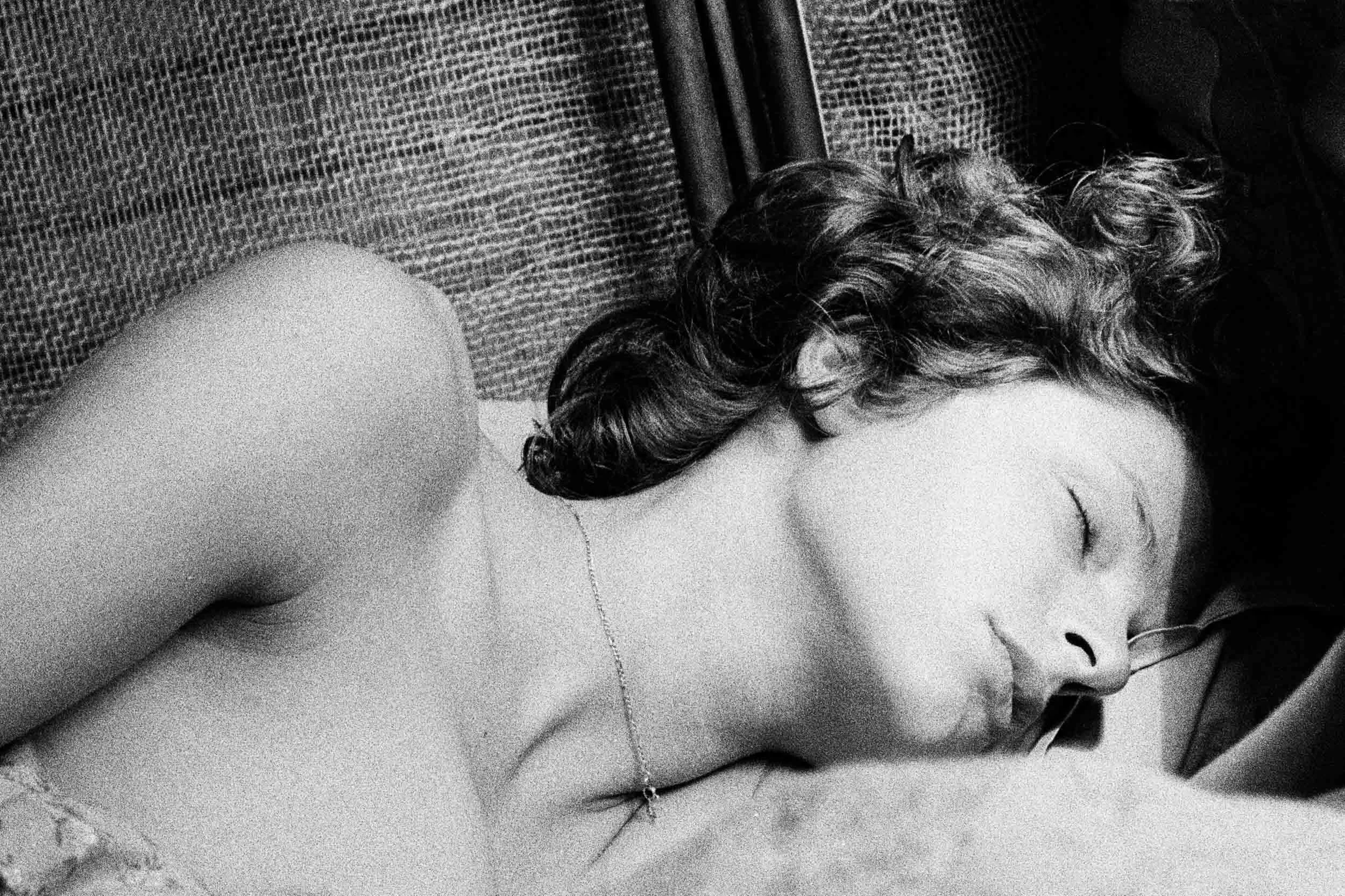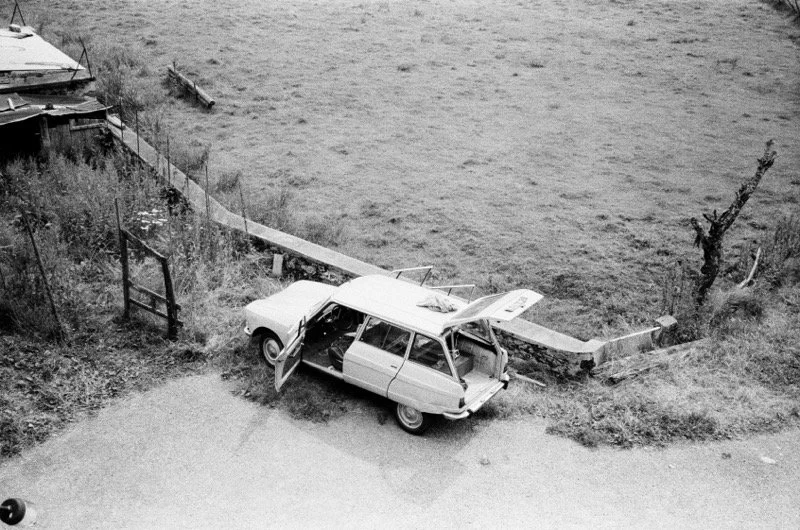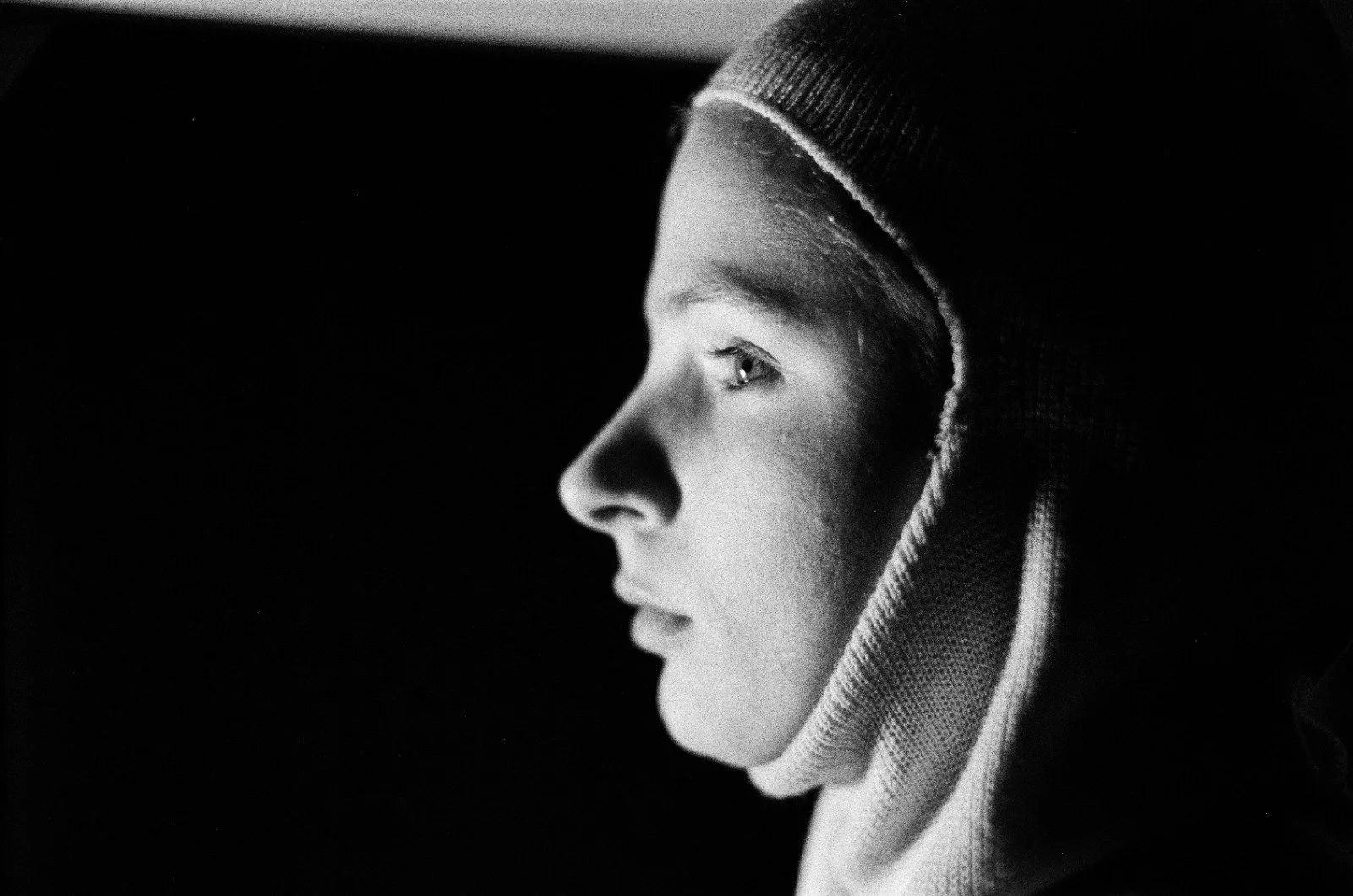I WONDER ABOUT REALITY.
WHEN, AS A CHILD, I WOULD LOOK UP AT THE STARRY SKY, I WOULD GET SCARED. BECAUSE IT WOULD REMIND ME OF THE CONCEPT OF INFINITY, BECAUSE THAT PHENOMENON IS NOT PRESENT IN EVERYDAY LIFE. IT WOULD FEEL LIKE A SHORT CIRCUIT IN MY BRAIN. REALITY WOULD STOP MAKING SENSE.
BEING IN AN UNFAMILIAR ENVIRONMENT, FAR AWAY FROM HOME, COULD RESULT IN SIMILAR EXPERIENCES. WHEN WE WERE IN SWITZERLAND, AND I SAW MOUNTAINS FOR THE FIRST TIME, I THOUGHT THAT MAYBE WE ARE ACTUALLY MINUSCULE, LIKE ANTS, OR EVEN INVISIBLE, TO A WORLD THAT IS MUCH LARGER THAN OURS, A WORLD SO LARGE THAT WE CANNOT SEE IT. AND SOMETIMES WHEN I WOULD BE IN THE CAR WITH PAPA, AND I WOULD LOOK UP AT THE SKY, WHICH I THOUGHT LOOKED LIKE A DOME, I THOUGHT I SAW THE OUTSIDE OF THE DOME OF ANOTHER WORLD.
. - Excerpt from “ES” A study based on journals by Ester spitz
Word and image in dialogue: ES
ES: ESTER SPITZ AND PIM KOPS
Writings and Photographs 1981–1983
CURATED BY VICTORIA CHAPMAN
I’m somewhere at the top of the theater in the dark. Next to me is a spotlight. I have my thoughts here. I have a good view—the spectacle is far away in the depths. I shine light on it. — Ester Spitz “ES”
This exhibition presents an intimate dialogue between word and image—a study based on journals of Ester Spitz and the evocative black-and-white photographs of Pim Kops. Drawn from formative years (1981–1983), the works trace the interior life of a young woman and the visual impressions of an observer moving quietly through the world.
At the heart of ES is a study of existence. The writings, culled from decades of journals, do not document a single identity but rather offer a lens into the human condition—its repetitions, its questions, its emotional contours. This is not memoir in the conventional sense, nor autobiography, but a meditation on consciousness, presence, and becoming. Each entry becomes a fragment of lived time, a mirror to the reader’s own inner landscape.
The accompanying photographs by Pim Kops, taken in the same era, serve as quiet witnesses. They reflect a parallel solitude: a gaze attuned to nuance, atmosphere, and the unsaid. Through these images, we glimpse both exterior world and intimate silence. They become metaphors for the interior terrain charted in Spitz’s writing.
Together, this collaboration explores vulnerability, resilience, and the poetics of the everyday. It is an offering of perspective: the written word from within, the photograph from without—both part of a greater act of witnessing. More than anything, ES invites us to pause and reflect,.
HAVE BOOTS FIXED PICK UP DRESS - Ester Spitz from “ES”
The collaboration between Ester Spitz and Pim Kops, created between 1981 and 1983, is situated within a lineage of artistic exchanges where writing and photography intertwine to articulate the complexity of being. Their work is deeply personal yet resonates with broader cultural currents of the time, when European art and literature sought to reconcile private experience with the shifting landscape of modernity.
Ester Spitz’s writings, a study of journals, offer a candid account of the self in formation. They oscillate between confession and meditation, narrative and fragment—echoing a tradition of women diarists yet also moving toward something less easily categorized. These writings are existential in tone, probing identity, desire, and the search for meaning.
Pim Kops’s photographs, meanwhile, preserve not simply the appearance of a subject but the atmosphere of intimacy itself. In these portraits of Ester, we encounter both presence and distance: the immediacy of her gaze and posture, and the quiet knowledge that the camera inevitably frames and fixes. Susan Sontag observed that “to photograph is to appropriate the thing photographed” (On Photography, 1977). Yet Kops’s images complicate this notion. They do not reduce Ester to an object of possession but instead reveal the reciprocal vulnerability of artist and muse. The camera here becomes not an instrument of control but a medium of trust.
Together, these writings and images construct a shared phenomenology of being. They are documents of youth and love, but also records of an existential search that transcends biography. What we witness is not only a relationship captured in fragments but also a cultural inquiry into intimacy, gender, and creativity in late-20th-century Europe.
Four decades later, their reunion in this exhibition allows us to revisit the question Sontag posed: what does it mean to preserve an instant, to fix in language or image what is by nature ephemeral? In the case of Spitz and Kops, the answer lies not in permanence but in resonance. These works endure because they remain unfinished, open—inviting each reader and viewer to continue the dialogue.
I DID NOT KNOW I OPENED A BOOK AND DISAPPEARED TO ANOTHER LIFE. WE STOOD IN THE CORRIDOR OF THE STATELY CANAL HOUSE WHEN HE TOLD ME I GOT THE PART.
SUDDENLY THERE WAS A TREE, IN BLOOM. FIRST THERE WAS NOTHING AND THEN IT WAS THERE.
I WENT DOWN A STAIRCASE AND DOWN A NARROW CORRIDOR, AT THE END OF THE CORRIDOR THERE WAS A DOOR, I WENT THROUGH THE DOOR AND ENTERED A LARGE ROOM WITH A MARBLE FLOOR AND LARGE WINDOWS OVERLOOKING A GARDEN AND THE BACKS OF THE HOUSES OF THE NEXT CANAL. THERE WAS A LOT OF LIGHT, SUNLIGHT FLOODED INTO THE ROOM. I ENTERED THE ROOM AND HE SMILED AT ME. HE SAT AT A TABLE BY THE WINDOW, GOT UP, SHOOK MY HAND AND SAID, ‘I AM JULIEN’. I SAT DOWN OPPOSITE HIM. HE WAS WEARING A STRIPED OXFORD SHIRT. HE TOLD ME HE LIVES IN AMERICA AND KNOWS THE SCHOOL WHERE I TOOK CLASSES VERY WELL. HE LOOKED AT ME AND ASKED ME QUESTIONS. HE LIKED MY ANSWERS. HE SMILED, HE PAID ATTENTION TO ME IN A WAY THAT NO ONE EVER HAS. HE LOOKED AT ME AS IF EVERYTHING I SAID AND DID WERE WONDERFUL LITTLE MIRACLES THAT I WAS SCATTERING AROUND, HE LOOKED AT ME AS IF ONE IS SUPPOSED TO BE PRECISELY LIKE I AM. - Ester Spitz “ES”
Behind the Exhibition ES
The process of shaping ES has been, above all, an act of listening—listening to words written in solitude and to photographs that hold their own quiet silences. From this, a rhythm emerged: the writings reveal the interior life, while the photographs witness the exterior. Word and image intertwine, weaving a narrative that does not belong solely to either artist but instead opens toward each viewer. In this way, ES becomes a meditation on the human condition—what it means to be free, full of life, melancholic, or to question reality itself.
The curation has been an experiment—setting parameters only to dismantle them. Ester shaped much of the selection herself, choosing either (1) a sense of atmosphere or story, or (2) simply the beauty of an image. If a photograph aligned with either approach, it entered the pool for consideration. There were countless striking images, but as curator I sought to shape a story about the human condition. Pim has the gift of capturing Ester and creating powerful compositions, yet Pim also had a large archive of images, so the selection process was not easy. Once we decided to integrate her text from ES, the project required an entirely new structure—one that spoke visually and through language, guiding the exhibition toward a form that could meet the public.
Our collaboration stretched across time zones—Ester calling Pim in Amsterdam, the three of us connecting on FaceTime, weaving together fragments of text and image. We considered printing in Los Angeles but chose instead for Pim to print in Amsterdam and ship the works. This felt right: he could make the final choices, and his presence would remain in the photographs—the smell of ink, the feel of paper, his hands reviewing each print.
Meanwhile, Ester and I created a mock installation with xeroxed images and torn pages from ES. While Pim prepared to print, we experimented in Los Angeles so the space would be ready to receive the originals with care. We worked touching the images, holding the text, walking the room. At first, we considered frames but abandoned them, deciding instead to hang the photographs directly alongside the book’s pages. This naked style felt truer, offering immediacy and sincerity to the viewer.
I cut the xerox images to scale and handed them to Ester to revisit. I gave her a structure: to pair images that formed part of an experience, to set others apart as single moments, and to shape new connections between image and text. Then there was a third layer—what Ester called the “pillars.” These became anchor points, around which the rest of the work was arranged.
We agreed Ester should lay the images on the floor, responding intuitively. Some works connected, others demanded space. The walls needed to breathe, and soon the room filled with emotion and thought. Pim suggested Ester record herself reciting the text, which we played in the background during the mock installation. This audio lightly brought together image and text. The pages, literally cut from ES, felt rebellious but necessary giving her words a stage beside the photographs, raw and luminous.
Once the layout was formed, we moved piece by piece to the wall, adjusting height and placement until the arrangement felt alive. We worked organically, moving up and down the wall, leaving the room and returning to sit quietly with our decisions. If something didn’t feel right the next day, we changed it and promised honesty with one another. Ester photographed each arrangement to review at home and share with Pim. My rule was simple: when Ester entered the space, she had to feel happy, that it reflected what she wanted. As curator, my role was not to impose emotion or opinion, but to hold the space and offer parameters from which Ester and Pim could leap.
One might say this project was an act of following the heart—guiding and being guided, meeting dead-ends, shifting direction, and allowing the work to speak.
To curate ES is to hold a dialogue between past and present, interior and exterior, word and image. It is to create a space where consciousness is mirrored back, and where what is most human—, fragility, and wonder—returns to the surface.
VICTORIA CHAPMAN, CURATOR
“ES” IS ON DISPLAY AT EL NIDO FROM OCTOBER 6 - NOVEMBER 15, 2025



